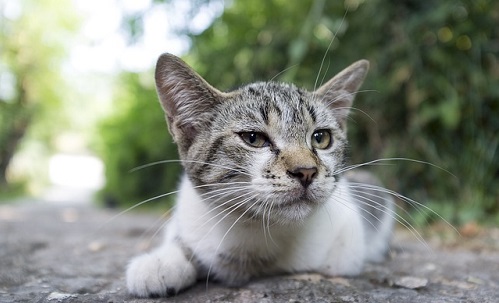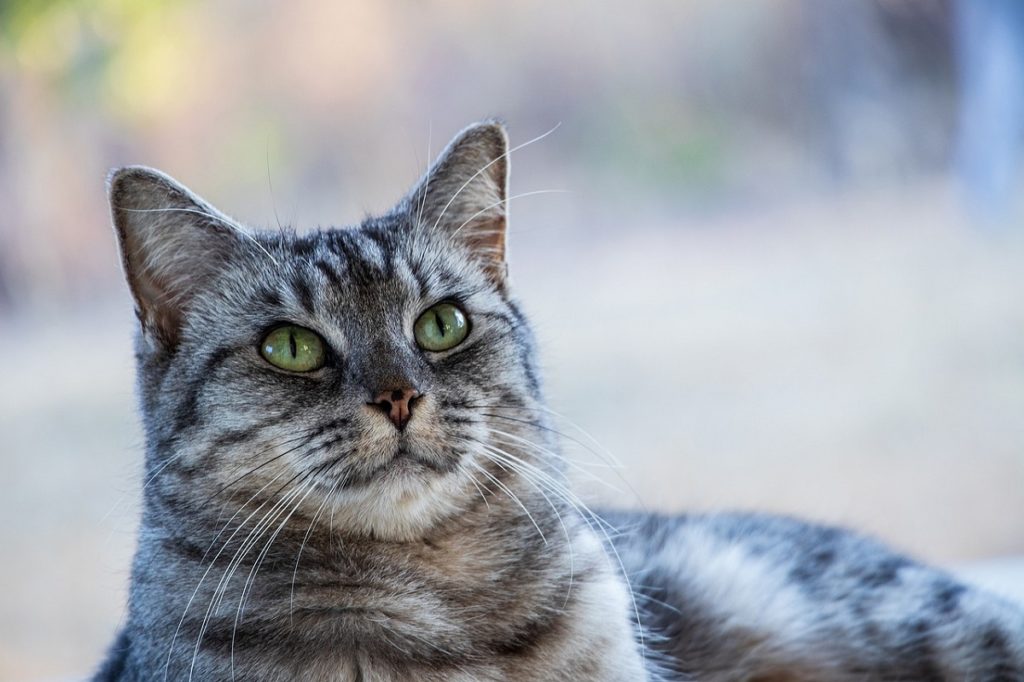When a cat moves around his environment, he generally makes very little noise. Hopping up on the back of a couch, stalking a cricket across the kitchen, eating, and drinking – it’s all done with relative silence. That’s why a sudden feline noise can send a loving cat owner into a panic, who may become worried about their companion and how they can help them feel better.
In addition to the chirps, meows, and purrs a cat uses to express himself, gagging, choking, and hacking are the sounds that signal varying levels of distress. If your cat keeps gagging, you should seek assistance from a medical professional as soon as possible. It’s up to his owner to determine the cause, and to get to the bottom of it quickly to prevent further health concerns. So what is the difference between a harmless cat “cough” and a more serious gagging reflex? The answer lies in logic, observation, and a little process of elimination.
Is He Actually Gagging?
When a cat grooms himself, he inevitably ends up swallowing and digesting some of his own fur, thanks to backward-facing tongue barbs called papillae. This hair ends up in the stomach, and when it can’t be properly passed by the digestive system, turns into a “cat hairball” that is later vomited up. The reflex that tells a cat it’s time for him to vomit one of these unwanted fur masses can be long, drawn-out, and according to some owners, just a touch dramatic.
 The physical posture of gagging for an immediate reason, such as choking on food or exposure to something harmful, will differ considerably from the hairball position – this is the key to determining the difference. When ejecting a hairball, a cat will sit low to the ground, extend his neck, and make undulating movements with his throat; it will look purposeful and free of panic. Gagging for an immediate cause will seem far more hurried and disorganized, and may also be accompanied by yowls or howls, or disoriented movements.
The physical posture of gagging for an immediate reason, such as choking on food or exposure to something harmful, will differ considerably from the hairball position – this is the key to determining the difference. When ejecting a hairball, a cat will sit low to the ground, extend his neck, and make undulating movements with his throat; it will look purposeful and free of panic. Gagging for an immediate cause will seem far more hurried and disorganized, and may also be accompanied by yowls or howls, or disoriented movements.
What Could Cause His Gagging?
When a cat is gagging due to an immediate cause, his owner will need to quickly determine the cause whenever possible. Considerations like these will help rule out potential causes quickly, determining whether or not he needs a few minutes to feel better or if a trip to the emergency vet is in order. Here are some scenarios to keep in mind when determining the cause of feline gagging:
- Has he been outside? If so, are there harmful native animals like poisonous snakes or spiders in the area?
- Has he been in potentially toxic-to-cats garbage, or around harmful cleaning chemicals that could have rubbed off on his fur and been groomed away?
- Could he have walked across a surface with a harsh cleaning substance on it and ingested it while cleaning his paws?
- Is he eating a new type of food that might not agree with him?
- Could something have fallen in his water bowl and tainted it, such as a moldy/mildewy piece of dry cat food or other foreign substance?
- Has he been spending time in a basement or crawlspace, where he might have been exposed to mildew or damp conditions?
- Is there any chance he could have bitten an animal that was poisoned, such as a rodent?
A cat is a natural predator, and his instincts will tell him to pounce, claw, and bite anything that moves like prey. He will explore his environment thoroughly, even if it contains residues or other items that could cause him respiratory or digestive distress. He will also groom himself if he feels unclean, which means there’s a high chance anything bad on his fur will end up in his mouth.
Once these potential ingestion issues have been explored and dismissed, it’s time to take a step back and look at the bigger picture.
Has His Environment Changed?
Humans gag when they smell something unpleasant or overpowering – it’s a species instinct designed to prevent toxins from entering the lungs. The facial expressions associated with gagging also send a clear visual message to any nearby humans: something is wrong, be on alert, and don’t come closer. The same is true of cats, which is why if a cat is gagging constantly, it’s a big red flag that his environment needs to be checked for harmful changes. Some common gag-causing issues include:
- Essential oil diffusers: These home fragrance items have become especially popular in recent years, as they spread a pleasant smell quickly throughout a home. Unlike scented candles, they do not need to be attended – the user simply plugs them in and fills a reservoir with essential oil. The diffuser then atomizes the oil through heat, sending tiny particles out to fill the air.
The problem: What goes up, must come down. All those tiny droplets of misted oil may smell good, but they’re also covering his fur. Disliking the strong fragrance, he will attempt to groom it away, and in the process ingest the essential oil. As any ethical essential oil label will plainly state, the concentration of essential oils are harmful to humans – and deadly to pets.
Incense and scented candles: Tried and true forms of home fragrance, these scented sources can be found in almost every home, particularly in necessary places like the bathroom or kitchen. They come in an almost infinite variety of scents and scent combinations, and are inexpensive enough to appeal to just about anyone.
The problem: Like essential oil diffusers, these fragranced items just can’t keep their molecules to themselves. The smoke and heavy fragrance they make can be completely overwhelming to a feline’s sensitive nose, causing your cat to wheeze, sneeze, and gag until the source of the odor is extinguished or removed. The longer these items are used in a home, the more their residue has a chance to build up on the surfaces a cat walks across, rubs against, or sleeps on.
Perfume, cigarettes, or vaping: Even when a human isn’t trying to fragrance their home, they may be doing it anyway, by accident. Wearing heavy colognes, perfumes, and body sprays means leaving the scent behind on couches and chairs frequented by a cat. Cigarette smoke leaves tar and ash behind, particularly with repeated use inside a home. Vaping is only a small step from an oil diffuser, spreading lightweight particles of scent, chemicals, and additives that are easily attracted to a cat’s fur.
The problem: Guests, relatives, and roommates may not be as conscious of a cat’s immune and respiratory system as his owner is. Unless told otherwise, they may believe that a cat that dislikes the smell will simply leave the room, not realizing that their fragrances remain on fabric surfaces, floors, and even walls for cat fur to pick up.
Scented cat litter or litter pan liners: If a cat has been exposed to scented litter or pan liners for a while, this is unlikely to be the cause of his gagging. However, if these products are a relatively recent addition to the household, there’s a good chance they’re at least exacerbating a cat’s gagging reflex. With so many brands available, even a well-meaning owner is more statistically likely to bring home a scented litter than not.
 The problem: Scented litter typically has a very strong fragrance, as it is designed to cover the equally-strong smells of cat feces and urine. However, that perfumed formula can have the opposite effect on a cat, who breathes in a great deal of it every time he needs to use the restroom. Whenever possible, unscented, low dust litter should be used and scooped often to prevent smells that offend both human and feline noses – in a pinch, a little baking soda can be mixed in with the litter for extra odor control.
The problem: Scented litter typically has a very strong fragrance, as it is designed to cover the equally-strong smells of cat feces and urine. However, that perfumed formula can have the opposite effect on a cat, who breathes in a great deal of it every time he needs to use the restroom. Whenever possible, unscented, low dust litter should be used and scooped often to prevent smells that offend both human and feline noses – in a pinch, a little baking soda can be mixed in with the litter for extra odor control.
Laundry products: With a huge emphasis on “fresh” scents, modern laundry products load up both the washer and dryer with strong perfumes. Everything from washable couch cushion covers to pet bedding picks up this scent, which tends to linger for long periods of time – to a pet parent’s delight and a cat’s displeasure.
The problem: Multiple layers of scents can leave clothes and linens looking visibly clean while actually making them chemically dirty. Scents in laundry detergent, dryer sheets, and scent additive “pearls” smell inviting to a human nose, but will overpower a cat’s sensitive predator nose, causing sneezing, choking, and gagging when interacting with the fabrics.
Has He Been Given Medicine?
Topical flea, tick, and worm medications are common for cats, who tend to put up more protest than dogs when it comes to pill-format medication. These medicines are usually sold or prescribed by vets in single-use vials, which are opened and applied between a cat’s shoulder blades to prevent them from licking it off. If a cat is gagging, drooling, or foaming at the mouth after being given a topical medication, but looks otherwise alert, there may be nothing to worry about.
The way topical medication interacts with a cat can sometimes cause them to drool or foam a little at the mouth, but if it looks to be excessive or the cat’s movement is impaired, a vet should be called immediately.
When using topical medication for a cat, an owner needs to:
- Verify the dose: Too much medication, which is typically doled out based on a cat’s total weight, can be harmful or toxic to him. A vet will have information about a cat’s weight, and can make recommendations about an appropriate dose of medication.
- Verify the formula: Cat and dog flea medications are typically not interchangeable. If a cat is having a bad reaction or prolonged drooling, shaking, or disoriented balance, the medicine packaging should be carefully examined to make sure no mistakes were made in administering it. In a multi-animal house, cat and dog medications that look visibly similar should be kept in distinct places to prevent a mix-up.
- Always put topical medicine close to the skin in a place where a cat cannot lick it off himself. While the medicine is designed to work inside a cat’s body, it’s formulated to be absorbed slowly through the skin, not swallowed quickly through grooming.
- Always carefully throw away any medicine debris and packaging to prevent a curious cat from licking or biting the vial or wrapper.
- Wash up: After administering the topical medication, an owner needs to wash their hands thoroughly before touching their cat; if not, they may transfer residue to their cat’s fur, where he can then lick it off.
- Isolate cats receiving treatment: In a multi-cat household, any treated cats need to be isolated for a full day – or longer, if the medication directions suggest – in order to prevent a cat from ingesting medication while grooming another.
Has His Cat Gagging Produced Anything?
Cats have an extremely hardworking and well-protected digestive system. Their body will naturally reject anything that is unsavory or harmful, with the exception of fast-moving toxins and poisons. Generally, if a cat is gagging, it’s merely his body attempting to expel something so that he can remain healthy and a top-notch survival hunter. Even in relatively “soft,” lethargic house cats, this gag reflex is alive and well, and coughing and gagging is a normal part of a cat’s life.
Know Your Cat’s Signals For Normal & Troublesome Gagging
 Productive gagging is informative, and allows the owner to look – albeit usually while wincing with disgust – at what has been ailing his feline friend. Depending on the amount of hair, mucus, bile, or blood, a gagging and vomiting cat is informing his owner on the state of his health. If he is continually gagging without producing a hairball, semi-digested food, or something else relatively expected, that’s a red flag that clearly points to an ongoing illness or an environmental concern.
Productive gagging is informative, and allows the owner to look – albeit usually while wincing with disgust – at what has been ailing his feline friend. Depending on the amount of hair, mucus, bile, or blood, a gagging and vomiting cat is informing his owner on the state of his health. If he is continually gagging without producing a hairball, semi-digested food, or something else relatively expected, that’s a red flag that clearly points to an ongoing illness or an environmental concern.
In short, unless a cat is making loud sounds of distress or constantly gagging, chances are he’s simply reacting to a momentary irritant in his immediate environment. Gagging is part of his hairball process of elimination, as well as a way to clear his throat, sinuses, or communicate displeasure at strong scents around him. An evolutionary trait, a cat’s gag reflex can be just as important to his survival as his skill stalking tasty mice, lightning-fast crickets, or that devious plastic cage ball with the jingle bell in the middle. Ultimately, pet parents must remain mindful of their cat’s signals in order to determine if their gagging is normal – or if it’s time to call the vet for an appointment.
Sources:
“Dry Heaving in Cats.” Wag Walking.com (Wag!), (no publish date), https://wagwalking.com/cat/symptom/why-is-my-cat-dry-heaving. Accessed June 24, 2019.
“Sneezing, Reverse Sneezing, and Gagging in Cats.” PetMD.com, (no publish date), https://www.petmd.com/cat/conditions/respiratory/c_ct_sneezing. Accessed June 24, 2019.
Millburn, Naomi. “How to Tell if It’s a Hairball Gag or Something Else in Cats.”Pets.TheNest.com, (no publish date), https://pets.thenest.com/tell-its-hairball-gag-something-else-cats-7922.html. Accessed June 24, 2019.
Syufy, Franny. “Essential Oils and Cats: A Potentially Toxic Mix.” The Spruce Pets.com, March 18, 2019, https://www.thesprucepets.com/dangers-of-essential-oils-555089. Accessed June 24, 2019.




